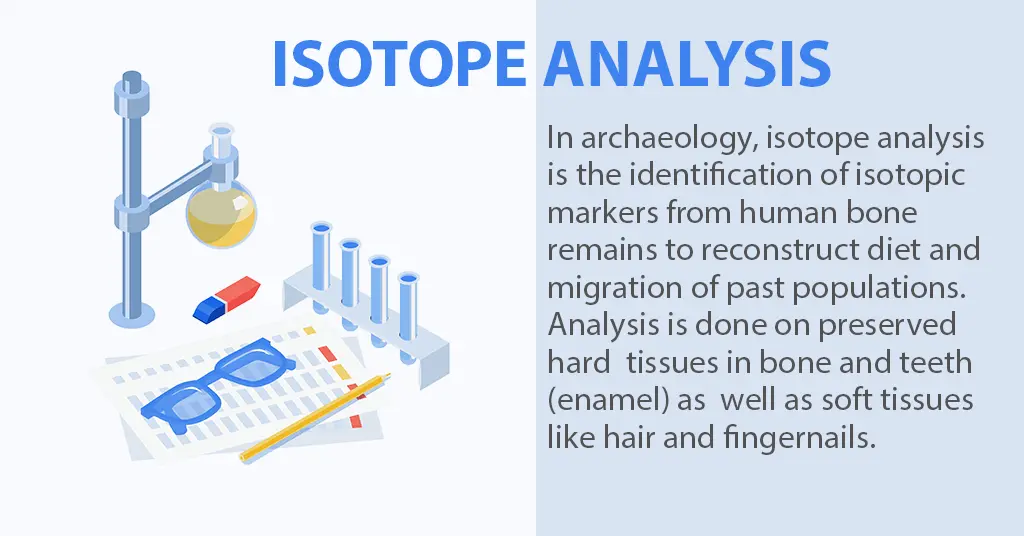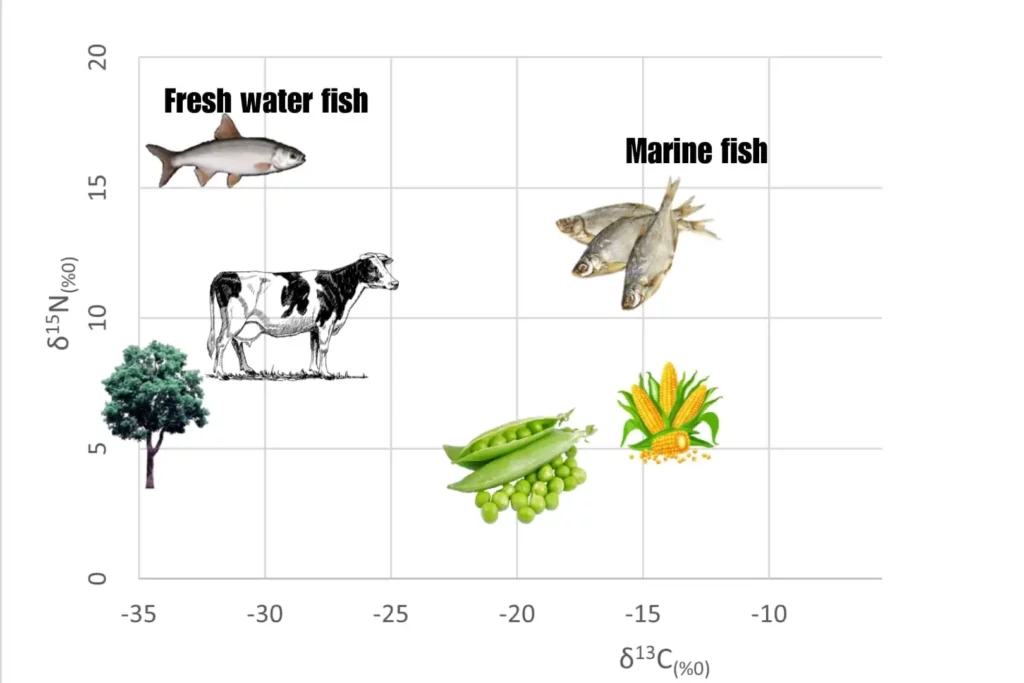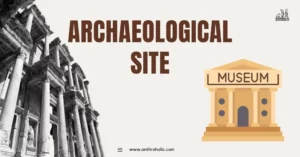AI Answer Evaluation Platform Live Now. Try Free Answer Evaluation Now
Isotope Analysis

Meaning and Origin
In archaeology, isotope analysis is the identification of isotopic markers from human bone remains to reconstruct diet and migration of past populations. Analysis is done on preserved hard tissues in bone and teeth (enamel) as well as soft tissues like hair and fingernails. The method is originally attributed to environmental, geochemical and geological studies; however, similar principles can be applied for bioarchaeological remains. The first application of isotope analysis in archaeology was done in 1970, in an Iron age site called Pharaborwa, in South Africa[1]. Since then, isotope analysis has become a seminal method which has helped understand the dietary patterns of hominin ancestors including Homo habilis and the Australopithecines.
Principle
Isotope analysis techniques examine the stable isotopic composition of ingested food and water during an organism’s lifestyle. Isotope signatures and their patterns are preserved in the environment which are absorbed by bones and tooth enamel through consumption. This allows researchers to infer the inhabited locations of those organisms. A wide range of elements can be considered for these studies since isotopes are variably present in all of them. Isotope ratios are generally measured using Accelerator Mass Spectrometry (AMS).
Applications of Isotope Analysis
Reconstructing Past Climates
An understanding of the environment, ecology and climate in which ancient populations existed helps in painting a picture of their challenges as well as survival skills. Since isotope signatures in different ecosystems vary reasonably, we can ascertain the source regions of idividuals or remains by comparing the soil – strontium and water – oxygen isotopes to the body isotope content of those individuals. Oxygen isotopes signatures vary geographically and reflect local temperatures and climates.[2] They can be used to study levels of precipitation, humidity, altitude and distance from the coast. Moreover, using paleoclimatic techniques we can understand the weather conditions of past localities and corroborate the two sets of data.
Migration
Migratory patterns can also be studied using isotope analysis. This method involves the preserved strontium in teeth enamel from the early childhood of an individual (since enamel is never replaced) which can help infer the birthplace of that individual.
These studies help trace individual organisms to particular regions. Additionally, animal remains are also analyzed for isotope signatures which can help identify non-local species and the nature of animal husbandry, transportation and mobility.
Such isotopic techniques of different elements are used together since atmospheric and hydrospheric oxygen is subject to several alterations due to environmental and chemical effects. [2]
Dietary Patterns
Isotope analysis is crucial in understanding past dietary habits. For this bone collagen, produced from a protein diet is implemented. The carbononates found in tooth enamel are called apatite and they are produced by a mixture of carbohydrates, fats and proteins [3].These carbon isotope signatures are preserved and retained for ten years, giving us an estimate of protein and other nutrients of the individuals.
Analysis of multiple teeth of an individual from childhood to adult life can indicate dietary changes over the lifetime of that individual. Collagen in samples from earlier periods (>40 kya) can be poorly preserved and degraded.
Presence of Nitrogen isotope signatures are used to ascertain marine-based diets like fish and other seafoods.[3] This helps indicate the nature of subsistence as well as food preferences of past communities.
Analysis from pottery is also done for isotopic content by examining the carbonized layers from residues found in cooking vessels and pots. This can identify the ingredients used as well as the nature of food recipes at an archaeological site.[4]

Conclusion
To summarize, the importance of isotope analysis in archaeological science is highlighted. With such groundbreaking techniques, researchers have been able to reconstruct past human dispersals and migration. This has helped further our understanding of our origins and genetic heritage. Additionally, isotope analysis provides impetus for studying past food habits, culinary practices and subsistence patterns. Isotope analysis has hence proven to be essential in archaeological research and subsequent anthropological interpretation, both socio-cultural and biological.
References
[1] Van Der Merwe, N. J., & Vogel, J. C. (1983). Recent Carbon Isotope Research and Its Implications for African Archaeology. The African Archaeological Review, 1, 33–56. http://www.jstor.org/stable/25130424
[2] Archaeological Science: An Introduction. (2020). India: Cambridge University Press.
[3] Tykot, R.H. (2004). Stable isotopes and diet : You are what you eat.
[4] Miller, Melanie J.; Whelton, Helen L.; Swift, Jillian A.; Maline, Sophia; Hammann, Simon; Cramp, Lucy J. E.; McCleary, Alexandra; Taylor, Geoffrey; Vacca, Kirsten; Becks, Fanya; Evershed, Richard P.; Hastorf, Christine A. (2020). Interpreting ancient food practices: stable isotope and molecular analyses of visible and absorbed residues from a year-long cooking experiment. Scientific Reports, 10(1), 13704–. doi:10.1038/s41598-020-70109-8
[5] Brather-Walter, Susanne (2019). Archaeology, history and biosciences (Interdisciplinary Perspectives) || Diet Reconstruction Based on C/N Stable Isotope Analysis: What Can It Contribute to Address Questions on Cultural Change?. , 10.1515/9783110616651(), 181–198. doi:10.1515/9783110616651-011




